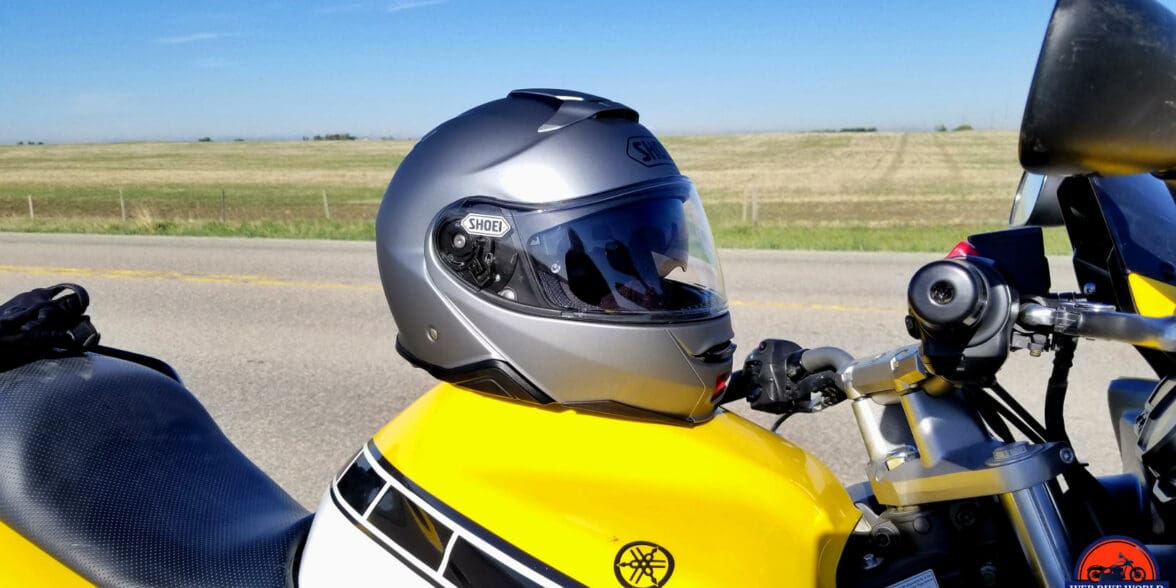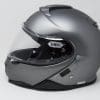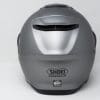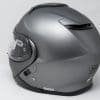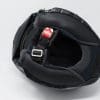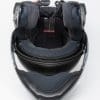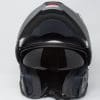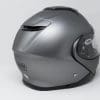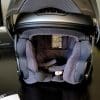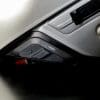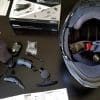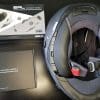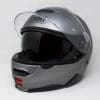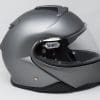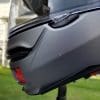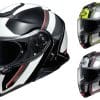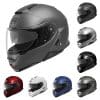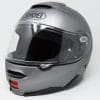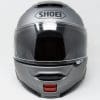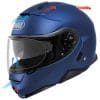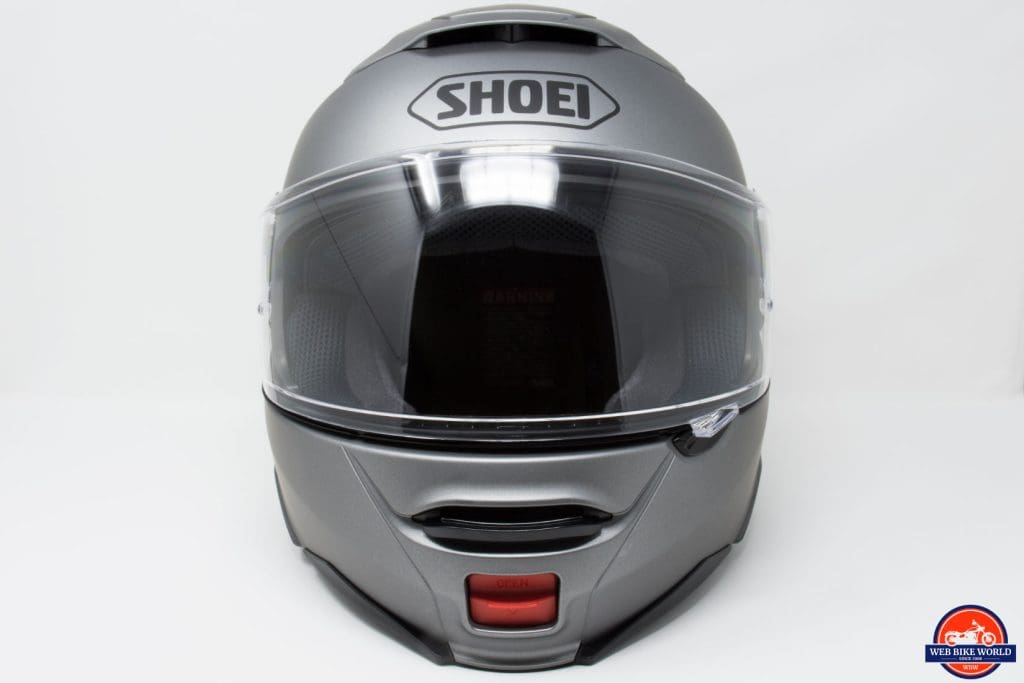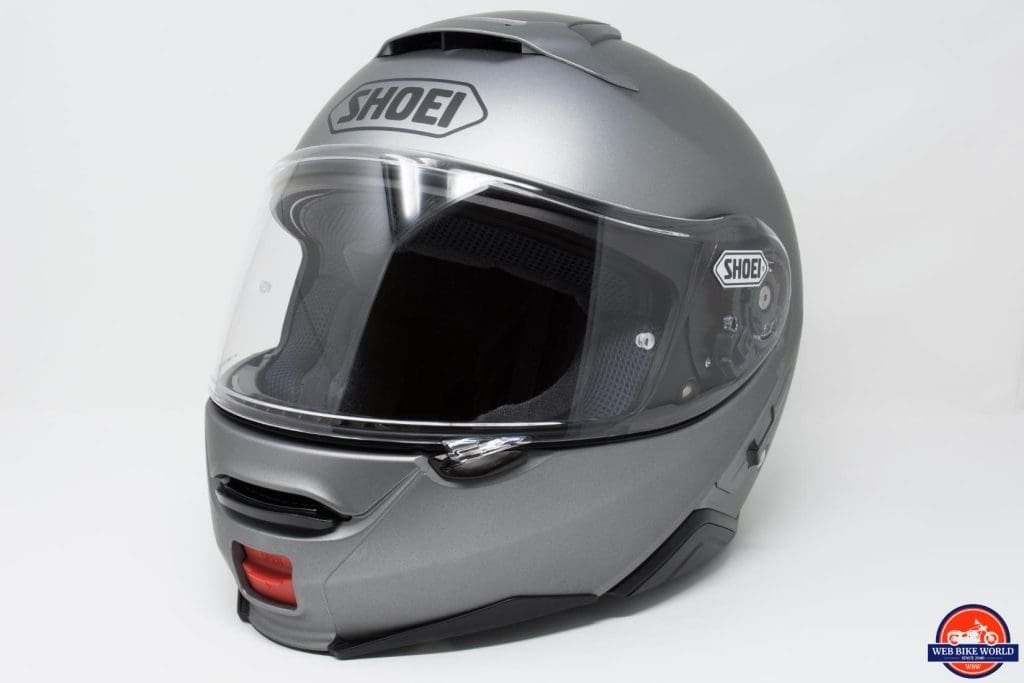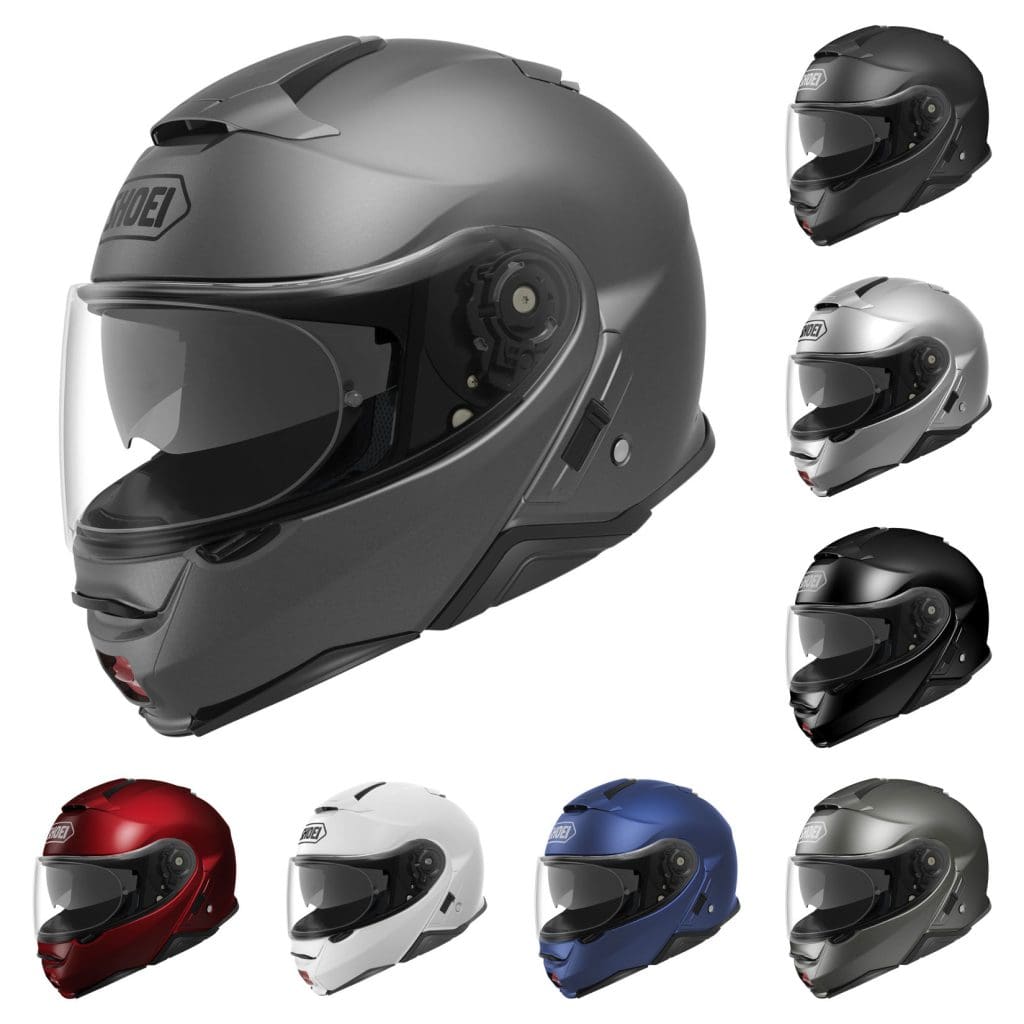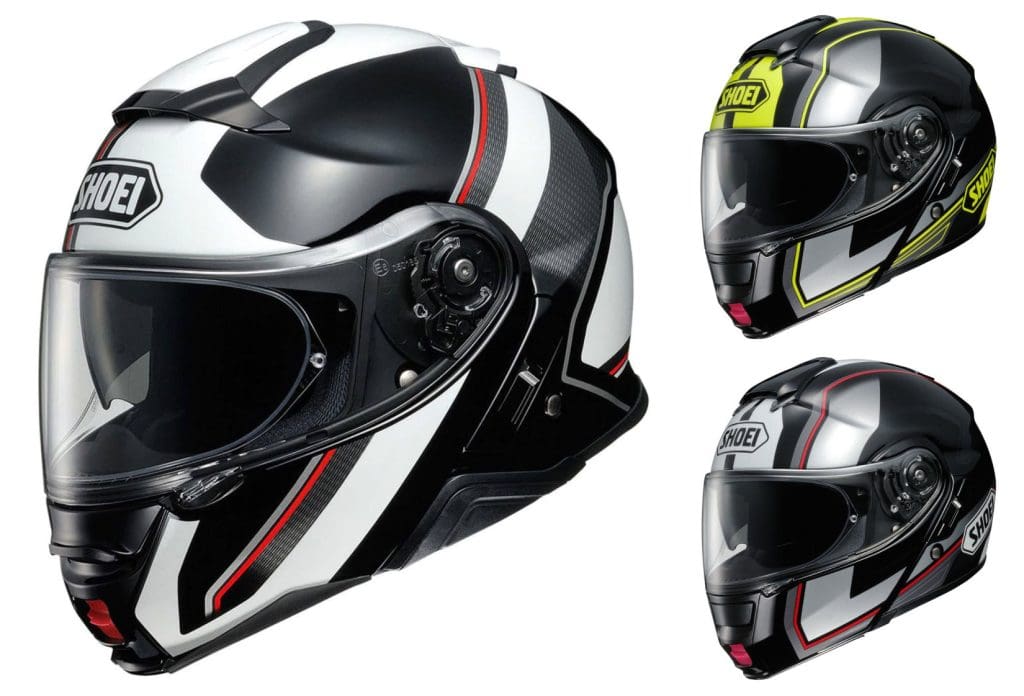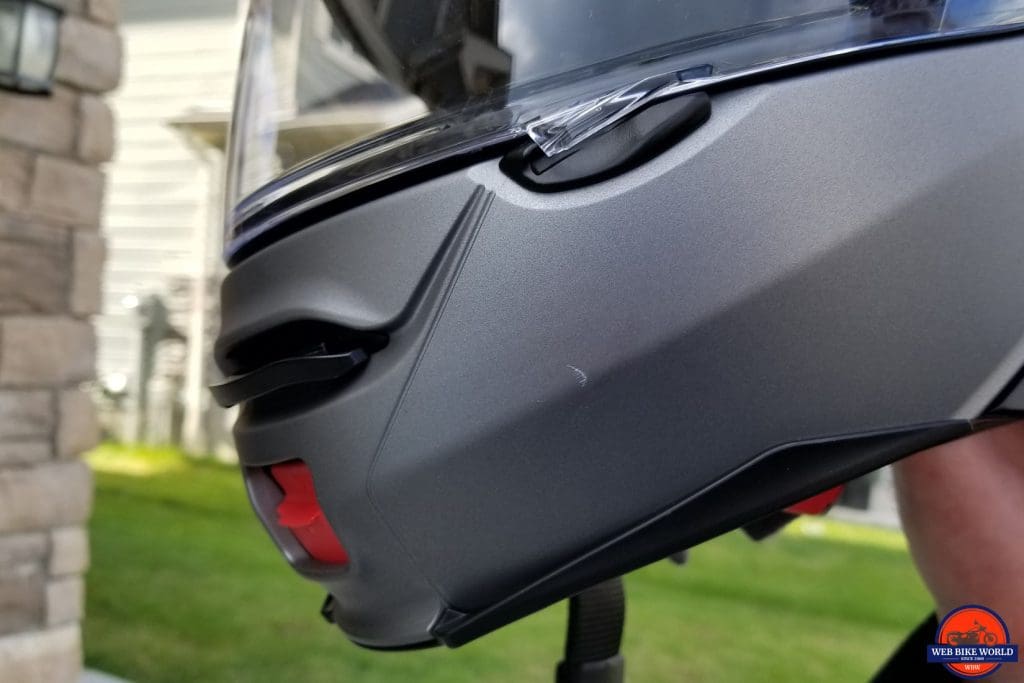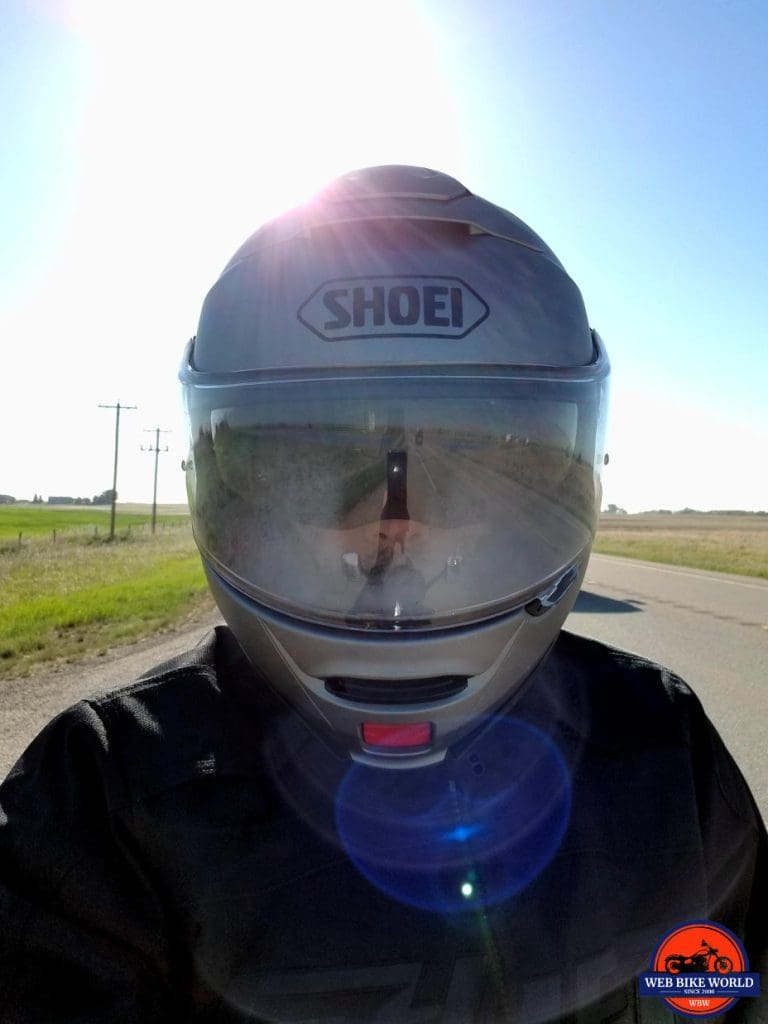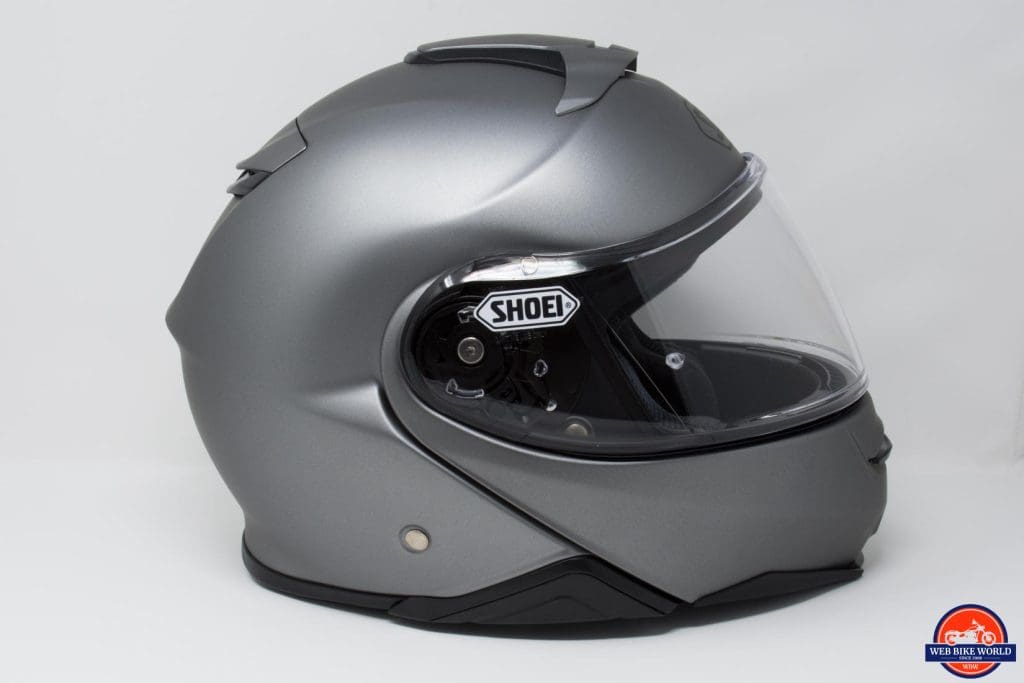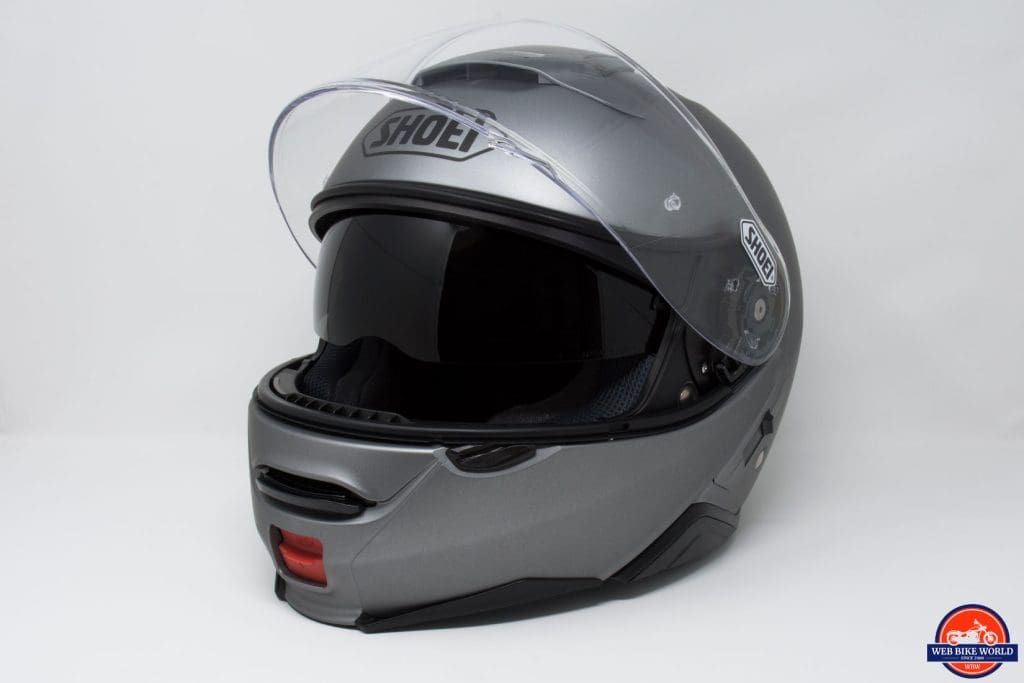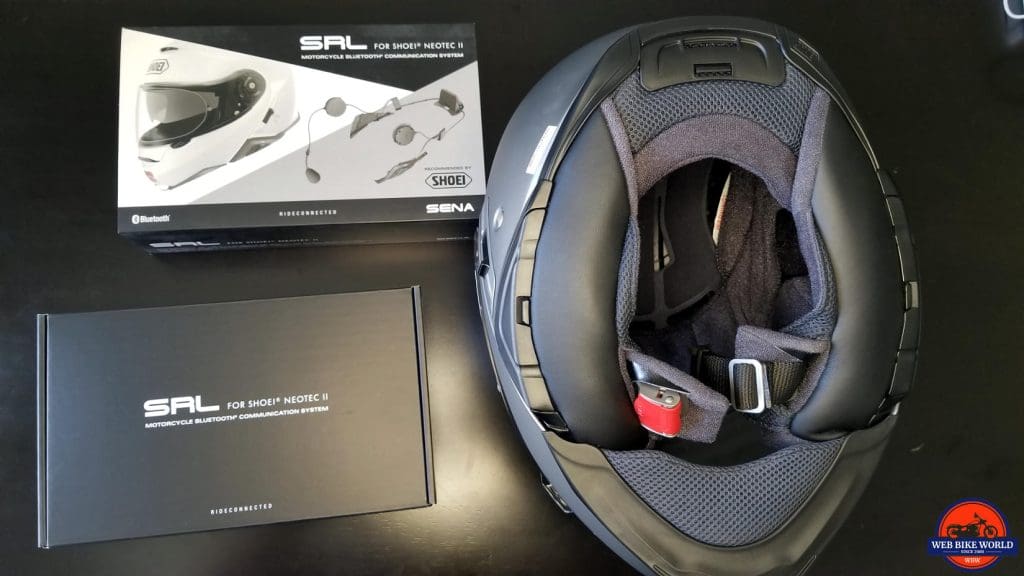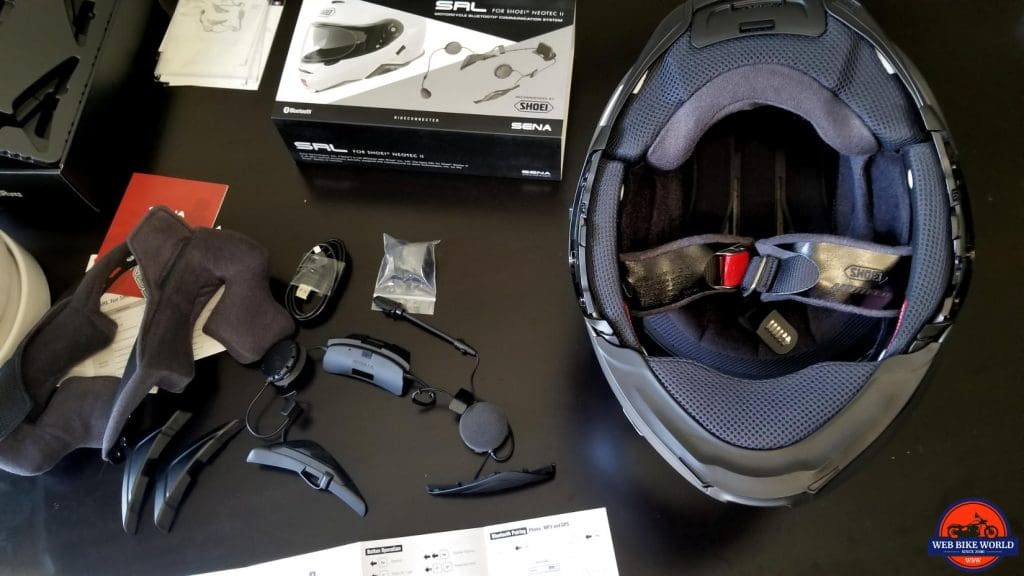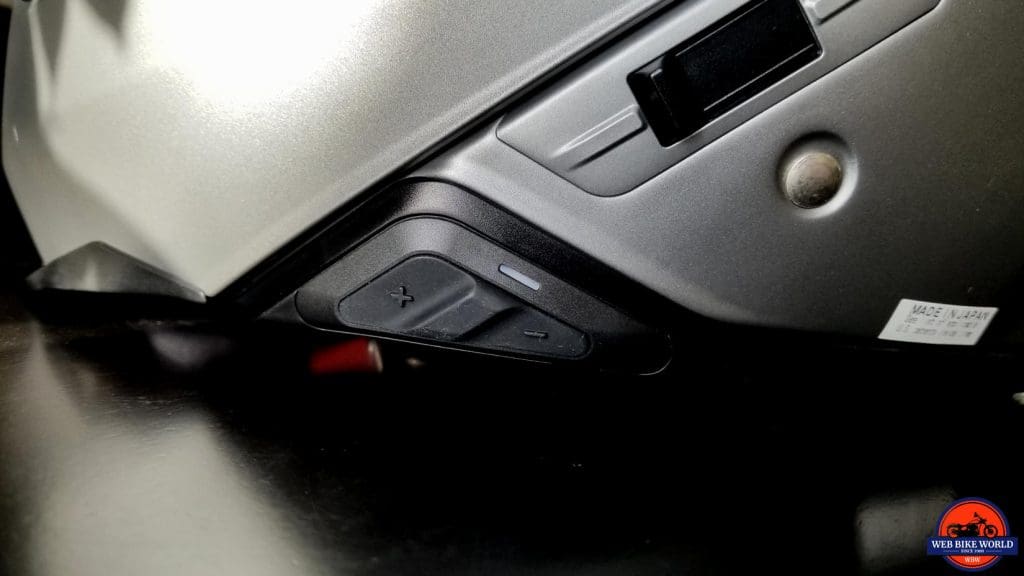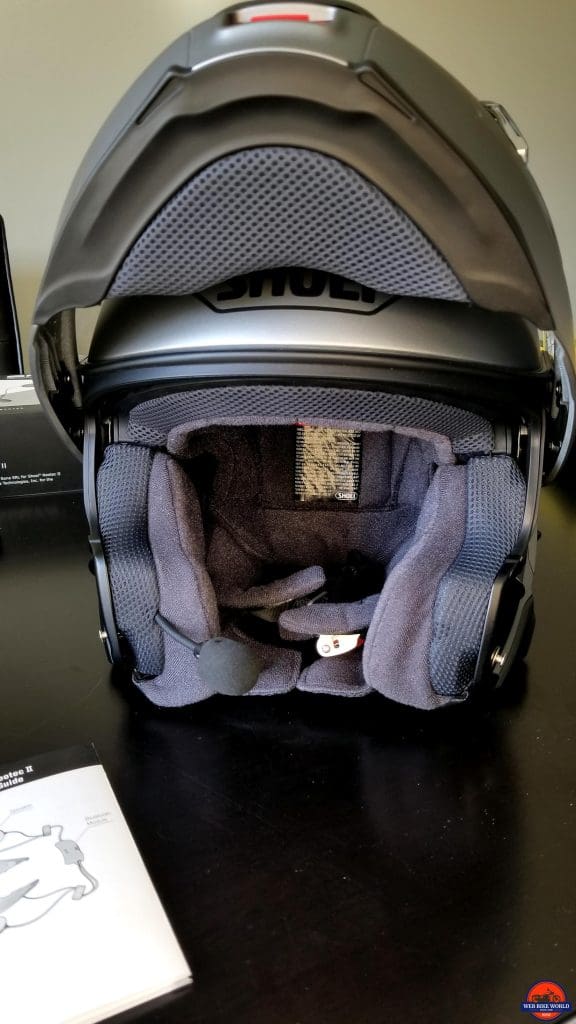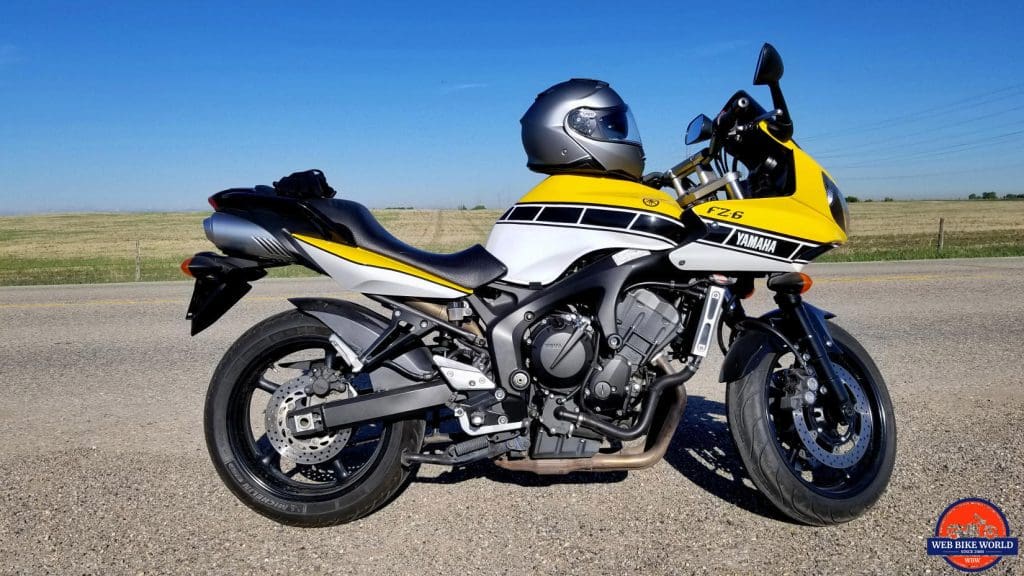wBW readers and fans of modular helmets everywhere will note that the original Shoei Neotec was introduced in 2012, and since its introduction it has rightfully earned and maintained its reputation as one of the best modular helmets around. In fact, earlier this year we selected it for our recommended modular helmets guide.
The Neotec gave riders exactly what they would have expected from a premium modular produced by a top-class brand like Shoei: exceptional build, great ventilation, an internal sun visor, and good ergonomics.
An act like that is tough to follow.
Still, the Neotec II does so with experienced confidence and easily earns a place as one of the segment leaders.
The Neotec II is new for this year, and while it’s easy to assume that it’s an evolution of the aging Neotec, most of the helmet has been rethought or upgraded. According to Shoei, the Neotec II is quieter, more comfortable, and features improved aerodynamics. You can (and should) reference our original Neotec review for comparison purposes as I don’t have an original Neotec handy for proper side by side.
Pricing for the Neotec II ranges, from $699 for single-color to $799 for something with graphics.
After a few weeks of riding, these are my thoughts on the Matte Deep Grey Shoei Neotec II.
Exterior Appearance & Finishing
From an aesthetic perspective, the matte finish on the tester I have here looks great. As you would expect from Shoei, the finish is top-notch. You won’t find any eggshelling, wraps at the seams, or variations in the color. The finish is even and uniform on every surface of the helmet.
The only splash of color on this colorway is the orangey-red chinbar release lever. Otherwise, it’s monochrome all around.
Compared to the original Neotec, the updated version is sleeker, with fewer lines and edges to disrupt them. Notably, the “forehead” partition is gone, and the upper vent is more distinct – looking a bit like a hood scoop – while the rest of the helmet is smoothly contoured and finished.
Other visual differences between the two:
- The chin vent is black and noticeably smaller compared to the color-matched vent on the Neotec
- The rear of the helmet is again streamlined, with the curve from front to back extending somewhat lower than the original
- The rear vent is more stylized, better flowing with the lines of the hemet
Personally, I think the Neotec II looks significantly better than the Neotec (which itself wasn’t a bad looking helmet).
Colorways
You can get the Neotec II in eight solid colors and three graphic versions. The solid colors are black, white, matte black, anthracite metallic, matte deep grey, light silver, matte blue metallic, and wine red.
The graphic versions are the Excursion TC-3 (yellow), Excursion TC-5 (grey/red/black), and Excursion TC-6 (white/red/black).
Finishing Quality
As mentioned earlier, the quality of the paint is quite good. It’s uniform throughout. However, the matte deep grey version I have here is already showing some blemishes.
I managed to scuff the paint doing I’m not sure what, as I haven’t dropped the helmet or hit anything that I’m aware of. A layer of clear coat may have prevented the scuff in question, but I suppose I’ll never know what caused it in the first place. Bummer.
Matte finishes are notorious for being more fragile than their clear-coated compatriots, so it’s hard to be more than a touch frustrated over the appearance of the white mark on the chinbar. Considering the light use the helmet had received up until that point – with barely 150km of seat time in it – I’m concerned that longevity of this colorway may be an issue.
The Neotec II will get plenty of use this summer, so I’ll post an update at the end of September and see how the finish has held up.
Fit & Comfort
The Neotec II fits a little snug. In his original Neotec review, Rick commented that the interior shape was “neutral to a T”, and I’d have to say the same thing about its predecessor. Most people will find the Neotec II comfortable to wear.
I haven’t noticed any pressure points while wearing it. It wraps firmly around my head and chin, but not to the point that it is uncomfortable. The helmet feels secure, moving and staying in position with my head as I rock my head backward and forward, left to right.
With the SRL integrated, the Neotec II weighs 4.2lbs, which is near the bottom of our 272 helmet comparison… and nearly right on top of the original Neotec.
Airflow & Venting
The chinbar vent is dual purpose: it brings airflow into the helmet to keep you cool, and it also keeps the visor free of fog. I haven’t had the ability to ride the Neotec II in wet weather (yet, Calgary is living in a drought at the moment), so I’m unsure of how changes in humidity would impact the system’s effectiveness. I will update the review when I have an opportunity.
The air brought in from the chin vent is directed towards the exhaust port – locked open. The top vent also routes via the exhaust. The chin vent is either open or closed, but the crown vent has three positions: open, somewhat open, and closed. With the vents closed there is a small but tangible reduction in road noise.
Pleasantly, air from the chin vent does not land directly on the eyes and avoids eye irritation- something I’ve experienced with other helmets.
Micro-Ratchet Strap
Shoei is using a micro-ratchet strap on the Neotec II. Unfortunately, I was never able to get the micro-ratchet strap as comfortable as I’d like. As a result, it always sort of pressed into my neck whenever I was looking down. At first I thought it was how I had it set up, and so I tried reconfiguring the lead given to mechanism, but I was only able to make it less uncomfortable as opposed to eliminating the discomfort entirely.
This is the only downer to the Neotec II. If this were a double-D ring I don’t doubt that it’d be perfectly comfortable. As it is, the micro-ratchet strap is an annoying but tolerable pain in the neck.
Also worth noting is that, so far, I’m the only person that’s tried it on to express said discomfort. Perhaps I’m an anomaly?
Fit
The rest of the helmet fits like a glove, as I’ve mentioned already. I can wear the Neotec II a long time without feeling neck fatigue, in part because the interior comfort system does an excellent job managing pressure.
The fit is unchanged with the addition of the SRL- the earpieces and microphone blend right into the overall design of the helmet and do not intrude in any way.
Noise
What really impresses me about the Neotec II is how quiet it is. It’s quite good for a modular.
The liner seals firmly against your head and chin, and the liner and interior comfort system work well together to keep unwanted sounds and vibrations out. There’s no whistling at speed, though wind buffeting is noticable (as it is on any helmet). Compared to the Vemar Sharki I reviewed last month, the Neotec II is considerably quieter inside.
Visibility
The viewport on the Neotec II is functionally identical to the original; the Neotec II is perfectly fine with respect to visibility, granting its wearer an expansive field of view. I do not feel my visibility while wearing it is at all restricted, and that extends well into my peripheral vision as well.
Face Shield
The face shield – the CNS-3 – is UV blocking and is a high-quality piece overall. It moves throughout its range of motion smoothly and feels secure doing it.
Optics are also quite good, with minimal distortion or haze that I can discern. Fact is, it’s a solid piece that does its job. You won’t notice that it’s there, which is kind of the point.
Pinlock Visor
A Pinlock EVO visor is included if you want to add it to the face shield.
Integrated Sun Visor
The built-on QSV-1 sun shield is one smooth operator. The left-side mounted slider – in the same spot and of the same design as the original Neotec – slides easily, with no sticking. Near the top of the range it will stay in whatever setting you leave it in, or it will snap to its uppermost position.
The visor provides ample sun protection, with 90% of the visible area shaded. Only about a fifth of my vision – the bottom left/right periphery – is unshielded.
In-Helmet Audio & Communication Via the SENA SRL
Both SENA and Shoei have been marketing the integration of the SRL for the Neotec II quite heavily. The system is designed to integrate seamlessly into the Neotec II, offering an aesthetically-pleasing way to listen to music, take calls, or use your smartphone’s navigation.
The SRL has a lot of functionality and shortcuts to learn- I’ll go into more depth in its dedicated review. Here, I’ll touch on how it works with the Neotec II.
Installation Tips
Installation of the system is easy – taking about 10-15 minutes the first time you do it – and the finished product looks great.
As the SRL is designed for the Neotec, the buttons look as if they always came with the helmet. There are no bulky control units on the side of the helmet, or any other visual indicator (aside from the microphone) that you’ve installed anything at all.
SENA has a handy installation video that makes the installation process a snap. I recommend following it vs. floundering about yourself.
Using the SRL
The left-side mounted buttons are easy to operate, though the process is somewhat clunky with gloves. SENA has various voice commands built-in; you simple say “hello, SENA” to get the AI-party started.
I prefer a more tactile approach and was able to learn the three-buttons positioning on the Neotec II quickly. The result is a system that is very intuitive to use when making simple adjustments, such as raising/lowering the volume or taking incoming calls.
Speaking of taking incoming calls, it’s a one-touch gesture to do so: when your phone rings, pressing the center button on the SRL will answer the call.
One thing to note: the pairing process is less intuitive than you’d think when looking at the quick guide.
- The guide calls for you to hold the center button for 12 seconds. After about 10 seconds, the intercom will announce pairing mode.
- Continue holding the center button for another 2 seconds, at which point the intercom will announce configuration menu.
- At that point, press the + button and the helmet goes into phone pairing mode.
I must have spent 10 minutes trying to get the helmet to pair before I discovered that “pairing mode” isn’t actually the mode to be in if you want to pair your phone.
Sound & Microphone Quality
Once you have everything paired up, using the SRL via your phone is like any other Bluetooth speaker/headset. The SENA Utility app allows you to configure the various settings of your SRL (things like audio compensation, multitasking, etc.).
Sound quality of both streaming audio/navigation and phone calls is pretty good. Calls are mostly clear at city speeds, and the person on the other end will hear you. Most people I talked to were genuinely surprised when I told them I was doing 30 – 50 mph on my motorcycle.
Streaming audio sounded surprisingly good considering the background noise of the bike, wind, traffic, etc.. The Neotec II is well-sealed with minimal air flow through the chinbar and visor port, the result of which is a good environment for in-helmet audio.
Well, as good of an environment as in-helmet audio gets, anyway.
However, at highway speeds, buffeting against the helmet drowns out the audio from the SRL at all but the highest volumes. Tucking into the slipstream improves this noticeably, and at city speeds, the audio quality is acceptable. You lose most bass tones when you’re moving quickly, but that is also true of any in-helmet intercom system.
Negative experiences with the SRL are limited to small things:
- There were a few instances where my phone lost connection with the helmet, once requiring me to pull over and re-pair the SRL to my Galaxy S8. The re-pairing situation only happaned once in the two-dozen drips or so I used it on.
- The SRL mouthpiece is always in place and sometimes it gets in the way. The chin protector often hits the microphone while being raised and lowered.
Overall, SENA’s SRL is the obvious companion to the Neotec II. It’s easy to install and asks for no aesthetic tradeoff. It sounds good and enhances the ride.
In Conclusion, the Neotec II is a Comfortable & Feature Rich Flip-Up Helmet
When your floor price is $699, it’s reasonable to have high standards. That’s a fair investment in your comfort and safety, and for that money, the Neotec II doesn’t disappoint.
Long-term durability of the finish may not be the best, but that’s also somewhat expected from a matte colorway. I’ll post an update at the end of the season to see how the finish has weathered.
All told, Shoei put out a truly excellent helmet in the new Neotec that offers its wearer the best in modular design and technology. It is a high-quality package that riders will enjoy and requires few compromises. The notable caveat here is the micro-ratchet strap, which is better than it was when I first got it but not as comfortable as the typical double-D (for me, anyway).
It’s price competitive with modular segment leaders and will be good option for a lot of riders. If you are currently shopping for a Klim TK1200, SCHUBERTH C4 or C3 Pro, then the Neotec II should also be on your list.
Disclosure: Shoei and SENA provided the Neotec II/SRL free of charge for my review.
Pros
Cons
Specs


